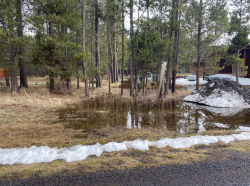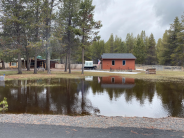Existing Residences in High Groundwater Areas
In South Deschutes County there are existing residences located in areas with very shallow water tables and served by old substandard conventional septic systems. Proposals to replace or remodel existing residences in high groundwater areas (groundwater less than 24 inches from ground surface) pose unique challenges where no septic system can be installed that meets all current site criteria per Oregon rules. Current information and experience show:
- The onsite wastewater treatment systems on these lots are polluting the unconfined aquifer that is the sole source of drinking water in the region. Data and modeling indicate that these locations may be more sensitive to pollution than other areas.
- Groundwater monitoring and modeling in the region have shown that existing onsite systems must be replaced to solve the nitrate pollution problem.
- Alternative Treatment Technology (ATT) wastewater treatment systems designed for residential use can reduce nitrogen loading to groundwater. (Note: Deschutes County does not guarantee that repairing or replacing the onsite systems on properties with high groundwater will alleviate any other site conditions associated with development in these areas. Current site criteria (a minimum of 24 inches of separation from ground surface to groundwater) still apply to all new site evaluations.)
- Permits for upgrades on high groundwater lots are issued as a reasonable installation to install the best and most protective system currently available for the property. The new system likely does not meet all site and system criteria in rule and may have operational challenges due to site conditions; however, treatment is significantly improved compared to the old substandard system.
Therefore, to protect public health and the environment, existing residences may be replaced or remodeled if all the following criteria are met:
1. An existing onsite wastewater treatment system currently serves an existing residence on the property.
2. The site does not meet minimum siting requirements for any type of system. For example, the site is in a high groundwater area.
3. The applicant is willing to abandon the existing system and complete the repair using the best available nitrogen-reducing technology. The replacement system will consist of an Alternative Treatment Technology (ATT) that includes a proven denitrifying design and is followed by a surface mounted bottomless sand filter for the soil absorption disinfection portion of the system. Sand filters may require additional modifications to promote proper function and best protect water resources.
4. The proposal for the replacement residence may include restrictions due to site conditions:
- The size and number of bedrooms may need to be limited to keep projected flow below a loading limit depending on lot size or site and water quality limitations. In most cases, no residence may exceed four bedrooms.
- Detached structures are excluded from the calculation of the square footage of the existing house if they have no plumbing.
- The sizing requirements are based on research that correlates the square footage of the house with flow (Sizing Onsite Systems). Large luxury homes can produce higher peak flows.
5. Any lots with a high-water table must have a wetland determination and/or delineation and the report or fill and removal permit submitted to the County.
- Contact the Oregon Department of State Lands for information on the wetland determination process. Oregon Department of State Lands : Welcome Page : State of Oregon
- Contact the Deschutes County Planning Division. A conditional use permit for fill and removal in wetlands or floodplains may be required from the Deschutes County Planning Division. Use our Contact Us form to inquire about Conditional Uses.
6. The upgraded septic construction-installation permit system must be installed and a Certificate of Satisfactory Completion issued prior to building final and occupancy.


